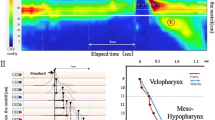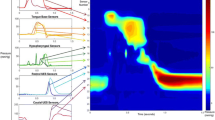Abstract
In deglutition the pharynx appears to act as a pump to “inject” boluses into the esophagus. A new method for measuring the velocity profile of the leading edge of a radionuclide bolus has been developed and applied to boluses of different viscosity—water and treacle—in nine normal volunteers. The results show that the more viscous bolus (treacle) acquires a slower initial “injection” velocity (152 mm/sec vs 236 mm/sec) that only propels it over the proximal half of the esophagus. Peristaltic action must drive the bolus over the distal half. With water boluses, however, the higher initial velocity is sufficient to propel a part of the bolus at least to the gastroesophageal junction leaving minimal “work” to be performed by esophageal peristalsis. This confirms the important role of the pharyngeal pump in deglutition. The pump may be the major mechanism for ingestion of nonviscous liquids (water), peristalsis merely being required to “sweep up” what remains in the esophagus.
Similar content being viewed by others
References
Cohen B, Wolf B: Cineradiographic and intraluminal pressure correlations in the pharynx and esophagus.In Handbook of Physiology, Sect 6, Alimentary Canal. CF Code (ed). Washington, DC, American Physiological Society, 1968, pp 1821–1839
Fisher M, Hendrix T, Hunt J, Murrills A: Relation between volume swallowed and velocity of the bolus ejected from the pharynx into the esophagus. Gastroenterology 74:1238–1249, 1979
Russell C, Hill L, Holmes C, Hull D, Gannon R, Pope C: Radionuclide transit: A sensitive screening test for esophageal dysfunction. Gastroenterology 80:887–892, 1981
Dent J: A new technique for continuous sphincter pressure measurement. Gastroenterology 71:263–267, 1976
Appelgate G, Malmud L, Roch E, Reilley J, Fisher R: “It's a hard pill to swallow” or don't take it lying down. Gastroenterology 78:1132, 1980
Author information
Authors and Affiliations
Rights and permissions
About this article
Cite this article
Buthpitiya, A.G., Stroud, D. & Russell, C.O.H. Pharyngeal pump and esophageal transit. Digest Dis Sci 32, 1244–1248 (1987). https://doi.org/10.1007/BF01296373
Issue Date:
DOI: https://doi.org/10.1007/BF01296373




